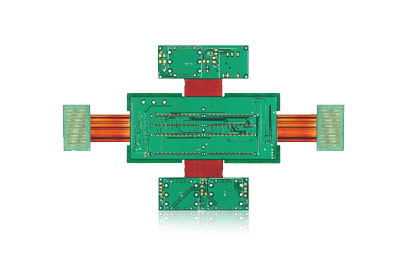Rigid-Flex PCBs
Rigid-flex PCBs combine flexibility with stability for high-reliability electronics.





Available structures for Rigid Flex PCBs
There are numerous, different structures available. The more common ones are defined below:
Traditional rigid flex construction (IPC-6013 type 4) Multilayer rigid and flexible circuit combination containing three or more layers with plated through holes. Capability is 22L with 10L flex layers.
Asymmetrical rigid flex construction, where the FPC is situated on the outer layer of the rigid construction. Containing three or more layers with plated through holes.
Multilayer rigid flex construction with buried / blind via (microvia) as part of the rigid construction. 2 layers of microvia are achievable. Construction may also include two rigid structures as part of a homogeneous build. Capability is 2+n+2 HDI structure.
Feature | Technical specification |
|---|---|
Number of layers | 4-26 layers |
Technology highlights | Mixed materials including RF and high speed, standard FR-4, polyimide flex. Adhesiveless or adhesive based polyimide flex constructions, with cover coat or flexible solder mask materials |
Bending performance | Based on the specific design, the bend performance can range from a basic 90 bend to fit to a full dynamic flex with 360 range of motion in the flex tail that will withstand continuous cycles throughout the product life |
Bend features | Bend radius controls the flexibility of the flex portion of the board. The thinner the material the lower the bend radius and the more flexible the flex section |
Materials | RA copper, HTE copper, FR-4, polyimide, adhesive |
Copper weights (finished) | 0.5 OZ, 1 OZ, 2OZ, 3OZ |
Minimum track and gap | 0.075 mm / 0.075 mm |
PCB thickness | 0.40 mm – 3.0 mm |
PCB thickness in flex section | 0.05mm x 0.8mm |
Maxmimum dimensions | 457mm x 610mm |
Surface finishes available | ENIG, OSP Immersion tin, Immersion silver |
Minimum mechanical drill | 0.20 mm |
Why SprintPCB can Provide the most
competitive PCBs
Under the long-term strategic cooperation agreement with laminate supplier , the price we get is 10% cheaper than most competitors
PCB Inner / outer layers fab with LDI equipment, the automatic production reduce our labor cost 5%
Lean manufacturing increases product yield
About SprintPCB
We can provide competitive price and guarantee the quality requirements of customers without excess quality. Our technical level can meet most of the industrial control and consumer products.
Manufacturing Equipment at SprintPCB
SprintPCB operate with most advance equipment in the industry to provide efficient production and high quality products with value added to our partners


Trusted by innovators since 2007
In the race to build tomorrow, SprintPCB engineers and PCB designers continually patent new technologies,
crossing design barriers—to help innovators bring new products to market.
"I am extremely satisfied with the quality of the PCBs you manufacture. The solder pads on each board are very smooth and the connections are very strong. I have worked with other manufacturers before, but the quality was always subpar. Since switching to SprintPCB, the quality of my projects has significantly improved. Thank you for your outstanding manufacturing process!"
- John Smith

Get High-Quality PCBs or PCBA at a Fraction of the Cost
Why Pay More for PCB Manufacturing?
Partner with Us for the Best Prices!
FAQ about Rigid-flex PCBs
A rigid-flex PCB is a type of printed circuit board that combines the benefits of rigid and flexible PCBs into one product. It consists of a rigid inner layer and a flexible outer layer, which allows for better versatility and flexibility in design and usage.
A standard PCB is typically made of a single layer of material and can only bend or flex to a limited degree. A rigid-flex PCB, on the other hand, has multiple layers and can bend and flex more easily, making it ideal for applications that require a lot of movement or compact design.
Rigid-flex PCBs offer improved durability, reduced space requirements, and better electrical performance compared to standard PCBs. They are also better suited for harsh environmental conditions, such as extreme temperatures, shock and vibration.
Rigid-flex PCBs are widely used in the aerospace, medical and telecommunications industries, among others.
The production process for a rigid-flex PCB is similar to that of a standard PCB, but with additional steps to create the flexible and rigid layers. The flexible layer is typically made from a polyimide material, while the rigid layer is made from a traditional PCB material, such as FR4. The two layers are then combined and laminated together to create the final product.
CONTACT US
We would love to respond to your queries and help you succeed.
During our business Hours: 9:00~18:00
